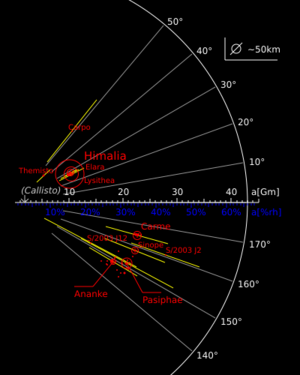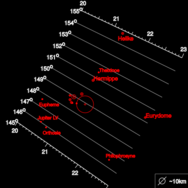Carme group
Topic: Astronomy
 From HandWiki - Reading time: 4 min
From HandWiki - Reading time: 4 min

The Carme group is a group of retrograde irregular satellites of Jupiter that follow similar orbits to Carme and are thought to have a common origin.
Their semi-major axes (distances from Jupiter) range between 22.7 and 23.6 Gm, their orbital inclinations between 164.4° and 164.9°, and their orbital eccentricities between 0.25 and 0.28 (with one exception).
The Carme group members are:[1][2]
| Name | Diameter (km)[3] |
Period (days)[4][lower-alpha 1] |
Notes |
|---|---|---|---|
| Carme | 46 | –734.19 | largest member and group prototype |
| Taygete | 5 | –732.45 | |
| Chaldene | 4 | –723.71 | |
| Kalyke | 5 | –742.02 | substantially redder than the others |
| Erinome | 3 | –728.48 | |
| Isonoe | 4 | –726.27 | |
| Aitne | 3 | –730.10 | |
| Kale | 2 | –729.64 | |
| Pasithee | 2 | –719.47 | |
| Arche | 3 | –731.88 | |
| Kallichore | 2 | –728.26 | |
| Eukelade | 4 | –730.30 | |
| Herse | 2 | –734.52 | |
| S/2010 J 1 | 2 | –736.51 | |
| Eirene | 4 | –729.84 | |
| S/2003 J 19 | 2 | –734.78 | |
| S/2017 J 2 | 2 | –724.71 | |
| S/2017 J 5 | 2 | –737.28 | |
| S/2017 J 8 | 1 | –719.76 | |
| S/2011 J 1 | 2 | –733.21 | |
| S/2003 J 9 | 1 | –736.86 | |
| S/2003 J 10 | 2 | –755.43 | |
| S/2003 J 24 | 2 | –721.60 | |
| S/2016 J 3 | 2 | –713.64 | |
| S/2018 J 3 | 1 | –747.02 | |
| S/2021 J 4 | 1 | –728.28 | |
| S/2021 J 5 | 2 | –747.74 | |
| S/2021 J 6 | 1 | –720.97 | |
| S/2022 J 1 | 2 | –738.33 | |
| S/2022 J 2 | 1 | –781.56 |
The International Astronomical Union (IAU) reserves names ending in -e for all retrograde moons.
Origin
The very low dispersion of the mean orbital elements[lower-alpha 2] among the core members (the group is separated by less than 900,000 km in semi major axis and only 0.5° in inclination) suggests that the Carme group may once have been a single body that was broken apart by an impact. The dispersion can be explained by a very small velocity impulse (5 < δV < 50 m/s).[5] The parent body was probably about the size of Carme, 46 km in diameter; 99% of the group's mass is still located in Carme.[6]
Further support to the single body origin comes from the known colours: all the satellites appear light red,[lower-alpha 3] with colour indices B-V= 0.76 and V-R= 0.47[7] and infrared spectra, similar to D-type asteroids.[8] These data are consistent with a progenitor from the Hilda family or a Jupiter trojan.
Notes
- ↑ Negative period is indicative of retrograde motion.
- ↑ Osculating orbital parameters of irregular satellites of Jupiter change widely in short intervals due to heavy perturbation by the Sun. For example, changes of as much as 1 Gm in semi-major axis in 2 years, 0.5 in eccentricity in 12 years, and as much as 5° in 24 years have been reported. Mean orbital elements are the averages calculated by the numerical integration of current elements over a long period of time, used to determine the dynamical families.
- ↑ With the exception of Kalyke, which is substantially redder.
References
- ↑ Scott S. Sheppard, David C. Jewitt, Carolyn Porco Jupiter's outer satellites and Trojans, In: Jupiter. The planet, satellites and magnetosphere. Edited by Fran Bagenal, Timothy E. Dowling, William B. McKinnon. Cambridge planetary science, Vol. 1, Cambridge, UK: Cambridge University Press, ISBN:0-521-81808-7, 2004, p. 263 – 280 Full text(pdf).
- ↑ David Nesvorný, Cristian Beaugé, and Luke Dones. Collisional Origin of Families of Irregular Satellites, The Astronomical Journal, 127 (2004), pp. 1768–1783 Full text.
- ↑ "Moons of Jupiter". Carnegie Science. Minor Planet Center. 27 August 2019. https://sites.google.com/carnegiescience.edu/sheppard/moons/jupitermoons.
- ↑ "Planetary Satellite Mean Elements". Jet Propulsion Laboratory. California Institute of Technology. 25 January 2024. https://ssd.jpl.nasa.gov/sats/elem/.
- ↑ David Nesvorný, Jose L. A. Alvarellos, Luke Dones, and Harold F. Levison. Orbital and Collisional Evolution of the Irregular Satellites, The Astronomical Journal,126 (2003), pages 398–429. (pdf)
- ↑ Sheppard, Scott S. (May 5, 2003). "An abundant population of small irregular satellites around Jupiter". Nature 423 (6937): 261–263. doi:10.1038/nature01584. PMID 12748634. Bibcode: 2003Natur.423..261S.
- ↑ Grav, Tommy; Holman, Matthew J.; Gladman, Brett; Aksnes, Kaare (2003-01-02). "Photometric Survey of the Irregular Satellites" (in en). Icarus 166: 33–45. https://arxiv.org/abs/astro-ph/0301016v1. Retrieved 2024-01-02.
- ↑ Grav, Tommy; Holman, Matthew J. (2003-12-22). "Near-Infrared Photometry of Irregular Satellites of Jupiter and Saturn" (in en). The Astrophysical Journal 605: L141–L144. https://arxiv.org/abs/astro-ph/0312571v2. Retrieved 2024-01-02.
External links
 |
 KSF
KSF


